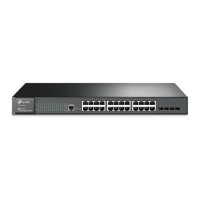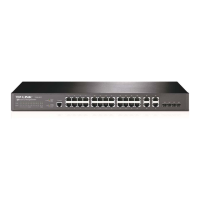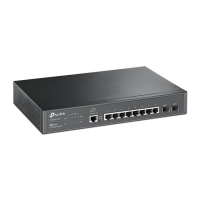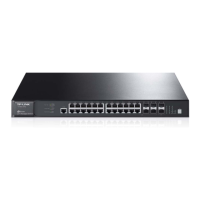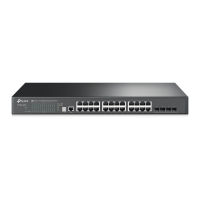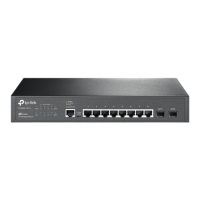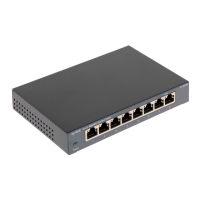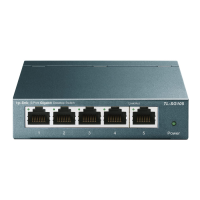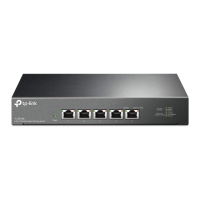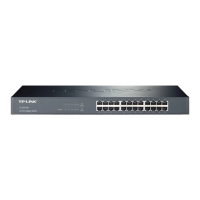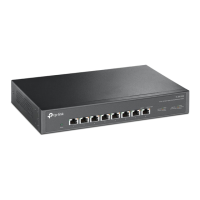Do you have a question about the TP-Link T2600G-28TS and is the answer not in the manual?
Identifies the target audience for this guide, assuming familiarity with IT concepts.
Explains the symbols and formatting used throughout the guide for clarity.
Provides a summary of the guide's structure, outlining the content of each chapter.
Introduces the JetStream Gigabit L2 Managed Switch, its features, and capabilities.
Details the physical components and layout of the switch's front and rear panels.
Provides instructions on how to access the switch's web management interface.
Explains how to navigate the main setup menu after successful login.
Covers basic system configuration including port status and device descriptions.
Details how to manage user accounts, access levels, and passwords for switch access.
Provides functions for managing configuration files, firmware, and system reboot.
Configures security measures for remote login and access control.
Manages hardware TCAM resources using different Switch Database Management templates.
Covers configuration of basic port features like status, speed, duplex, and flow control.
Details Link Aggregation Group configuration for combining ports into a high-bandwidth path.
Monitors traffic statistics and summary for each port.
Manages MAC address tables, including static, dynamic, and filtering entries.
Configures Layer 2 Protocol Tunneling for transmitting Layer 2 protocols across networks.
Explains VLAN tagging and port link types for 802.1Q VLAN configuration.
Details how to classify VLANs based on MAC addresses for enhanced network segmentation.
Allows VLAN classification based on network protocols like IP, IPX, and ARP.
Configures Virtual Private Network functionality using VLANs for secure connections.
Manages dynamic VLAN registration and propagation using GARP VLAN Registration Protocol.
Explains Private VLANs for Layer 2 separation and efficient VLAN resource usage.
Covers global configuration of Spanning Tree Protocol, including modes and parameters.
Configures Spanning Tree parameters for individual ports, including priority and path costs.
Manages Multiple Spanning Tree Protocol instances for VLAN-to-instance mapping.
Provides protection functions against malicious attacks on Spanning Tree features.
Enables and configures Ethernet OAM function, mode, and discovery status on ports.
Configures parameters for OAM link events, thresholds, and detection periods.
Configures notification for link faults like dying gasp and critical events.
Initiates remote loopback testing to ensure link quality during installation or troubleshooting.
Displays detailed Ethernet OAM traffic and event log statistics for specific ports.
Monitors physical cable configuration and detects unidirectional links using DLDP.
Manages multicast groups by snooping IGMP messages between hosts and routers.
Distributes IPv6 multicast data efficiently by selectively forwarding to interested ports.
Displays and configures IPv4/IPv6 multicast address tables for forwarding streams.
Configures Layer 3 interfaces, including VLAN, loopback, routed ports, and IPv6 features.
Displays summaries of routing information generated by various routing protocols.
Manually configures static routes for stable networks to improve performance.
Manages IP address allocation and configuration for network clients via DHCP.
Configures DHCP Relay Agent to forward DHCP requests between clients and servers.
Manages IP-to-MAC address mappings in the ARP table and configures static ARP entries.
Classifies packets and maps them to priority queues using DiffServ for QoS implementation.
Controls traffic rate and broadcast flow on ports using Rate Limit and Storm Control.
Configures Voice VLANs to prioritize voice data streams for quality transmission.
Specifies time-ranges (absolute, week, holiday) for ACL rules to take effect.
Creates and manages Access Control Lists (ACLs) including MAC, IP, and IPv6 ACLs.
Defines policies to control data packets by matching ACL rules and configuring actions.
Binds ACLs to specific ports or VLANs to enforce access control policies.
Applies policies to specific ports or VLANs, controlling data packet processing.
Binds IP, MAC, VLAN ID, and Port number to enhance network access control.
Binds IPv6 address, MAC, VLAN ID, and Port number for network access control.
Monitors DHCP process to record host information for automatic IP-MAC binding.
Monitors IPv6 address acquisition from DHCPv6 server for automatic binding.
Detects and filters illegal ARP packets to prevent ARP attacks.
Verifies IPv6 Neighbor Discovery packets using MAC binding to filter forged ND packets.
Filters IP packets based on IP-MAC binding entries to enhance bandwidth utility.
Analyzes IP packets to distinguish and defend against malicious DoS attack packets.
Implements port-based network access control for authentication and security.
Extracts Vendor-Specific tags for authentication, authorization, and accounting (AAA).
Configures authentication, authorization, and accounting services for network access.
Configures SNMP globally, including views, groups, users, and communities.
Configures the switch to report important events to the management station.
Monitors network traffic and performance using RMON groups like History and Statistics.
Configures LLDP globally, including transmit interval and fast start mechanism.
Views LLDP information of the local device and its neighbors.
Displays LLDP statistics for local devices, including neighbor counts and errors.
Configures LLDP-MED parameters for managing endpoint devices like Voice over IP phones.
Monitors CPU and memory utilization status through data graphs.
Monitors network traffic at high speeds using sampled flow technology.
Records, classifies, and manages system information for monitoring and diagnosis.
Provides Cable Test functionality to diagnose network cable connection issues.
Tests network connectivity and gateway reachability using Ping and Tracert.
Identifies the target audience for this guide, assuming familiarity with IT concepts.
Explains the symbols and formatting used throughout the guide for clarity.
Provides a summary of the guide's structure, outlining the content of each chapter.
Introduces the JetStream Gigabit L2 Managed Switch, its features, and capabilities.
Details the physical components and layout of the switch's front and rear panels.
Provides instructions on how to access the switch's web management interface.
Explains how to navigate the main setup menu after successful login.
Covers basic system configuration including port status and device descriptions.
Details how to manage user accounts, access levels, and passwords for switch access.
Provides functions for managing configuration files, firmware, and system reboot.
Configures security measures for remote login and access control.
Manages hardware TCAM resources using different Switch Database Management templates.
Covers configuration of basic port features like status, speed, duplex, and flow control.
Details Link Aggregation Group configuration for combining ports into a high-bandwidth path.
Monitors traffic statistics and summary for each port.
Manages MAC address tables, including static, dynamic, and filtering entries.
Configures Layer 2 Protocol Tunneling for transmitting Layer 2 protocols across networks.
Explains VLAN tagging and port link types for 802.1Q VLAN configuration.
Details how to classify VLANs based on MAC addresses for enhanced network segmentation.
Allows VLAN classification based on network protocols like IP, IPX, and ARP.
Configures Virtual Private Network functionality using VLANs for secure connections.
Manages dynamic VLAN registration and propagation using GARP VLAN Registration Protocol.
Explains Private VLANs for Layer 2 separation and efficient VLAN resource usage.
Covers global configuration of Spanning Tree Protocol, including modes and parameters.
Configures Spanning Tree parameters for individual ports, including priority and path costs.
Manages Multiple Spanning Tree Protocol instances for VLAN-to-instance mapping.
Provides protection functions against malicious attacks on Spanning Tree features.
Enables and configures Ethernet OAM function, mode, and discovery status on ports.
Configures parameters for OAM link events, thresholds, and detection periods.
Configures notification for link faults like dying gasp and critical events.
Initiates remote loopback testing to ensure link quality during installation or troubleshooting.
Displays detailed Ethernet OAM traffic and event log statistics for specific ports.
Monitors physical cable configuration and detects unidirectional links using DLDP.
Manages multicast groups by snooping IGMP messages between hosts and routers.
Distributes IPv6 multicast data efficiently by selectively forwarding to interested ports.
Displays and configures IPv4/IPv6 multicast address tables for forwarding streams.
Configures Layer 3 interfaces, including VLAN, loopback, routed ports, and IPv6 features.
Displays summaries of routing information generated by various routing protocols.
Manually configures static routes for stable networks to improve performance.
Manages IP address allocation and configuration for network clients via DHCP.
Configures DHCP Relay Agent to forward DHCP requests between clients and servers.
Manages IP-to-MAC address mappings in the ARP table and configures static ARP entries.
Classifies packets and maps them to priority queues using DiffServ for QoS implementation.
Controls traffic rate and broadcast flow on ports using Rate Limit and Storm Control.
Configures Voice VLANs to prioritize voice data streams for quality transmission.
Specifies time-ranges (absolute, week, holiday) for ACL rules to take effect.
Creates and manages Access Control Lists (ACLs) including MAC, IP, and IPv6 ACLs.
Defines policies to control data packets by matching ACL rules and configuring actions.
Binds ACLs to specific ports or VLANs to enforce access control policies.
Applies policies to specific ports or VLANs, controlling data packet processing.
Binds IP, MAC, VLAN ID, and Port number to enhance network access control.
Binds IPv6 address, MAC, VLAN ID, and Port number for network access control.
Monitors DHCP process to record host information for automatic IP-MAC binding.
Monitors IPv6 address acquisition from DHCPv6 server for automatic binding.
Detects and filters illegal ARP packets to prevent ARP attacks.
Verifies IPv6 Neighbor Discovery packets using MAC binding to filter forged ND packets.
Filters IP packets based on IP-MAC binding entries to enhance bandwidth utility.
Analyzes IP packets to distinguish and defend against malicious DoS attack packets.
Implements port-based network access control for authentication and security.
Extracts Vendor-Specific tags for authentication, authorization, and accounting (AAA).
Configures authentication, authorization, and accounting services for network access.
Configures SNMP globally, including views, groups, users, and communities.
Configures the switch to report important events to the management station.
Monitors network traffic and performance using RMON groups like History and Statistics.
Configures LLDP globally, including transmit interval and fast start mechanism.
Views LLDP information of the local device and its neighbors.
Displays LLDP statistics for local devices, including neighbor counts and errors.
Configures LLDP-MED parameters for managing endpoint devices like Voice over IP phones.
Monitors CPU and memory utilization status through data graphs.
Monitors network traffic at high speeds using sampled flow technology.
Records, classifies, and manages system information for monitoring and diagnosis.
Provides Cable Test functionality to diagnose network cable connection issues.
Tests network connectivity and gateway reachability using Ping and Tracert.
| Model | T2600G-28TS |
|---|---|
| Category | Switch |
| Switching Capacity | 56 Gbps |
| Forwarding Rate | 41.7 Mpps |
| Layer | Layer 2+ |
| Power Supply | 100-240V AC, 50/60Hz |
| Fan Quantity | 2 |
| Mounting | Rack Mountable |
| MAC Address Table | 16K |
| Jumbo Frame | 9KB |
| Storage Temperature | -40°C to 70°C (-40°F to 158°F) |
| Operating Humidity | 10% to 90% non-condensing |
| Storage Humidity | 5% to 90% non-condensing |
| Ports | 4 x 1G SFP slots |
| Management | Web, CLI, SNMP |
| Dimensions | 440 x 180 x 44 mm (17.3 x 7.1 x 1.7 in) |
| Standards and Protocols | IEEE 802.3i, IEEE 802.3u, IEEE 802.3ab, IEEE 802.3z, IEEE 802.3x, IEEE 802.1q, IEEE 802.1p, IEEE 802.1d, IEEE 802.1s, IEEE 802.1w |
| Quality of Service | Support 802.1p CoS/DSCP priority |
| VLAN | Supports up to 4K VLANs simultaneously (out of 4K VLAN IDs) |
| Operating Temperature | 0°C to 40°C (32°F to 104°F) |
